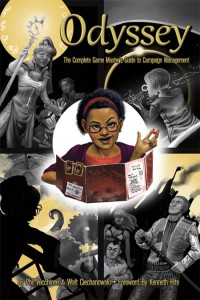 Author: Phil Vecchione, Walt Ciechanowski
Author: Phil Vecchione, Walt Ciechanowski
Publisher: Engine Publishing
Art Director: John Arcadian
Price: Print & PDF $24.95 / PDF $11.95 / PDF @ RPGNow ($11.95)
Pages: 212
Odyssey: The Complete Game Master’s Guide to Campaign Management is the most recent release from Engine Publishing in print and PDF form, plus bonus EPUB, MOBI and text versions. The book is written by Phil Vecchione (also author of Never Unprepared from Engine Publishing) and Walt Ciechanowski, with art by Avery Liell-Kok, Matt Morrow, Christopher Reach, and Daniel Wood.
Odyssey is a guide to managing campaigns. With that in mind the book covers three major topic areas – starting a campaign, managing a campaign, and ending a campaign. A shorter section defining campaigns starts the book. The book aims to be an in-depth guide to helping a GM guide a campaign from the time it is just an idea, starting the campaign, running the campaign and making it past obstacles that can occur, to wrapping up your campaign.
The book weaves a fictional gaming group amongst the advice to help show how situations can work out better using the advice in the book. The technique works well for this purpose.
Let’s take a look at the book section by section.
On Campaigns
Before the book gets too far into helping you manage a campaign it defines a campaign. Four elements are noted that make up a campaign – characters, gaming sessions, a series of events, and continuity.
Working from there the book moves into why one would want to manage a campaign. Here the book briefly goes into the phases of the campaign, a closer look at the layers of the campaign, and the constant tides of risk and change and their impact on the campaign. This all helps make the case as to why a campaign can benefit from management.
This section is short, but serves well to set the stage for the rest of the book.
Starting a Campaign
The first part of a campaign is starting a campaign. This chapter begins by defining four main phases of starting a campaign. This includes coming up with the campaign concept, the framework, creation, and the first session. The first chapter in this section defines the role of GM and of the players that make up the gaming group as well as key skills for people starting a campaign.
This takes us to the Campaign Concept chapter. This chapter breaks down the elements of forming the concept for the game. The ground rules or blocks that are going to form the foundation of the campaign. Methods of coming up with these ideas as a group or GM are included, along with advantages and disadvantages of each method.
Next we move into the Campaign Framework chapter. This section goes over what I would call the “meta” of the campaign. What system are you going to use, setting, what supplements are allowed, house rules, and even social contracts at the table. The chapter goes into more depth on choosing a setting and what other factors to consider as part of the framework – like roles of the PCs, power level, etc.
Campaign creation gets a short chapter. This chapter aims to help a GM organize his material and consider several elements that go into campaign creation from the GM’s side of the screen.
And finally, this section wraps up with a section on the First Session. This chapter tackles how to handle that first session. I always think the first session of any campaign is one of the hardest. Getting the characters involved in the new world always seems tricky to me, no matter how excited I am for the new campaign. There were several good tips on here on how to get the most out of that first session.
Managing a Campaign
This section jumps right in with the first chapter titled Campaign Management. The chapter is an overview of what is to come, noting five areas of focus. Story, player characters, people, risk, and change. The chapter goes on to talk about being agile and flexible with the areas of focus and avoiding a strict railroad in running a game.
 Story management dives into several good bits of information. Everything from story arcs to ways to hook players into the arc. There is also a section on story structure and touches on the three-act and five-act models plays as something to mimic. The chapter also touches on pacing, the importance of interesting NPCs, and other story related elements that need managed.
Story management dives into several good bits of information. Everything from story arcs to ways to hook players into the arc. There is also a section on story structure and touches on the three-act and five-act models plays as something to mimic. The chapter also touches on pacing, the importance of interesting NPCs, and other story related elements that need managed.
Player Character Management comes up next. The authors touch on different character types, growing a character during a campaign both in character and mechanically. There are also tips on how to showcase this growth during sessions.
People Management covers a multitude of real life people scenarios that can impact your game and frequently need some management. Everything from scheduling issues, to problem player types that can disrupt a campaign. The chapter closes with tips on keeping interest in the campaign – both the GM’s and the player’s.
Risk Management is a short chapter that helps a GM use a four step process for managing risks. These steps help determine what risks might be, how likely they are to occur (to help determine how much time to spend on them), and how to mitigate the risk. This was a handy chapter and helps drive home that there is always risk, but not all risk warrants time spent on detailed plans to mitigate, while others might.
The final chapter in this section is Change Management. This chapter also covers four steps to use to address change that might occur in your campaign. This change could be anything from a new player joining the group to a long term player leaving the group.
Ending a Campaign
The first chapter in this section is titled When It Is Time To End Your Campaign. Several warning signs that it is time to consider ending your campaign are listed. The authors also note that ending a campaign is not necessarily a bad thing.
Killing a Campaign comes next as one of the ways to end a campaign. Four common approaches to this method are mentioned and how to implement each of those in your own campaign. And even if a campaign must be killed, the chapter reminds you to look at why the campaign failed and learn from it.
The next chapter covers methods to Suspend a Campaign. The first topic addresses determine whether a campaign should be killed rather than suspended. If interest exists to continue at a later date, then suspending the campaign might be an option. The chapter covers how to suspend it and how to bring it back when the time has come to do so.
The final option mentioned is the Managed Ending. This is where the campaign simply has loose ends tied up because the campaign has run its course. This is a chance to explore final areas players have been desperate to do so or tie up any other loose ends that might exist. The grand finale!
Summary
Odyssey: The Complete Game Master’s Guide to Campaign Management is another excellent offering from Engine Publishing. Campaign management is an often overlooked component of RPG books. Very few RPG publishers give the topic an in-depth look. Campaigns are what keep people playing and successful campaigns are what keep people coming back to the table. The practical advice included in Odyssey is a methodical look at managing a successful campaign and avoiding common pitfalls, a welcome resource to both new GMs and seasoned GMs alike. The fact it is system neutral helps further its usefulness to an even greater number of GMs.
In addition to the usefulness of the subject matter, the book flowed well making reading about such management techniques of a campaign enjoyable. The mixing of the fictional gaming group stories applying the techniques were useful examples further illustrating the relevance of the techniques.
Pairing Odyssey with Never Unprepared and a new or seasoned GM is well on their way to smooth running sessions and campaigns.

Thanks for reviewing Odyssey! I’m glad you enjoyed it.